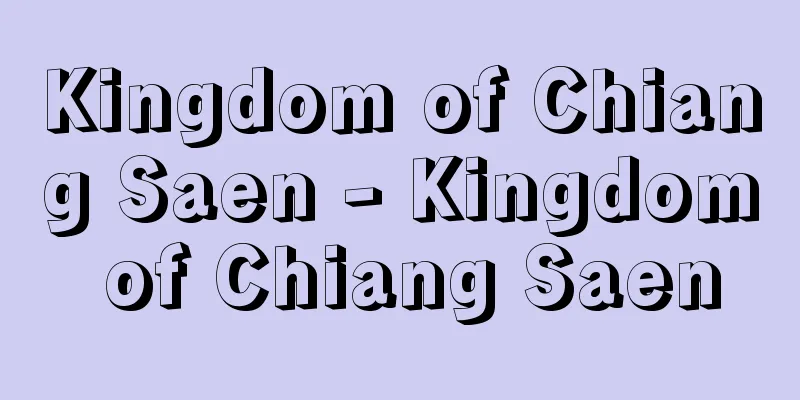Music

|
Music is the product of human artistic activity, unfolding within a certain time and space, by using various characteristics of acoustic phenomena in an orderly manner. This world of sound, constructed using bodies and objects, is organically incorporated into the lives of humans as social beings, is endowed with cultural meaning and value, and fulfills social functions according to circumstances. Music has played an important role in the vertical and horizontal expansion of human culture, passing on and transforming with the passage of time, and spreading and transforming across regions. [Osamu Yamaguchi] Music as a conceptSemantics and musical conceptsThe word "onaku" is a modern term used in China and neighboring countries that corresponds to the English word "music" (in French, musique, in German, musica, in Italian, and mūsīqī, mūsīqā in Arab countries). The first written appearance of the term "onaku" was in the "Lu Shi Chunqiu" (3rd century BC), which is believed to have been written during the Qin dynasty in China, and in the "Shoku Nihongi" (797) in Japan. Although the term has been used in various places since then, the meaning does not match that of today, and it seems to have often referred to a specific genre or piece of music. The Chinese term equivalent to "onaku" is "raku," which is one concept in the three-division system of "voice" (something that is felt and moves), "sound" (when it changes and takes shape), and "music" (when the sounds are layered and enjoyed). There is a theory that the pictograph "楽 (樂)" means playing a stringed instrument with "strings (幺)" strung on "wood" with "white (claws)". Another interpretation is that two "幺 (riding drums)" are placed on a "wood" stand and "Utsu (shiro)" is being played. In either case, the original meaning is playing an instrument, and the nuance also includes the fact that it refers to music for the upper classes. In Japan, there is a custom of using the character "楽" to mean "music," and it often refers to gagaku and other forms of music. The appropriate reading of the character "楽" is "asobi" or "asobu." However, "asobi" is a Yamato word with multiple meanings that refers not only to music but also to hunting and other special activities somewhat removed from daily life. Incidentally, even today in the Amami Islands and Okinawa, words such as "asobi" and "uta asobi" are used as synonyms for musical performance. In Japanese, there are other general terms such as "mononone," "uta," and "onkyoku," but each has a limited range of connotations, and "ongaku" has come into general use since the Meiji period. In India, the Sanskrit word sagīta has been used as a general term since ancient times, which includes gīta (song), vādya (musical instrument), and ntta (dance). In Western Asia, apart from āvāz (Persian) and ghinā' (Arabic), which mean "song," mūsīqā (Arabic) is sometimes used. In Europe, the only terms that came from the various languages were those that meant "song" or "melody." For example, song and tune in England, chanson and mélodie in France, Gesang and Lied in Germany. The situation is often similar among other ethnic groups. Examples include lagu (Malay) in Southeast Asia, nyimbo (Tanzania) in Africa, and elitakl (Belau) in Micronesia. Due to this background, the term "music" is now widely used around the world. It began in Europe when various peoples established loanwords based on mousikē (Greek) and musica (Latin). The Greek mousikē was an adjective meaning related to the Muses (singular: Muses), which became a noun. The Muses are nine goddesses born to Mnemosyne, the goddess of memory, by Zeus, the chief god of Greek mythology. They were responsible for epic poetry, lyric poetry, tragedy, comedy, music, dance, history, astronomy, etc. Thus, mousikē encompasses the arts related to words, movement, and time, such as language, poetry, music, and dance, as well as human behavior when engaged in these arts. The theoretical and academic character that was already present in the term was further strengthened, and the concept of musica in medieval Europe became clear. That is, it is a theory of harmonia that focuses on the numbers and proportional principles that govern nature and the universe, and distinguishes between three types of music: Musica instrumentalis or Musica sonora is the real music produced by organs (voices) and instruments (musical instruments), Musica mundana, which is said to be the basis of Musica mundana, is the music of the universe, and Musica humana is the music of the human soul. Based on this theory, Musica came to be included in the seven liberal arts, along with rhetoric and arithmetic, in the Schola educational institution. As the history of European music has flourished since the Middle Ages, the term "music" has steadily taken root in various countries. As a result of the colonial policies of the 18th to 20th centuries, it has spread to other lands as well. However, in the second half of the 20th century, the idea of cultural relativism, which accepts different cultural values, became prominent, and accordingly, there was a trend to respect the various musical styles of the world. This is reflected in the encouragement of the use of plurals, such as "musics" in English, and the attitude of not treating different musical cultures as the same. [Osamu Yamaguchi] Relationship with surrounding areasMusic, as a human activity, is not something that can stand alone in itself, but exists in relation to various surrounding fields. Even Western music, which is said to have achieved a high degree of autonomy, is based on the premise that it will be heard in reality, and is therefore placed within a certain social and cultural context, and therefore cannot be free from extramusical effects. The area in which music has the deepest relationship is language. First, speech based on pronunciation is a form of communication directed to the listener, just like music. Second, there is a direct interrelationship in that vocal music, one of the major forms of music, incorporates words (lyrics). Third, some essential parts of musical concepts are verbalized as musical terms at various levels, and the act of "talking about music" is carried out in everyday life and in special ways (music criticism, musicology, etc.). The first of these is a problem directly related to the structural relationship between music and language, in that the use of sound is either segmental or metrical, or a combination of both. More specifically, the so-called talking drums of West Africa are sometimes used to narrate dynastic genealogies, to greet people, and in court cases, while imitating words and carrying linguistic meanings. Furthermore, when European bells, Oceanian slit drums, and Buddhist musical instruments are sounded in a certain pattern at certain times of the day, they not only create a certain atmosphere but also convey a certain message. Physical movement also has an inseparable relationship with music. The act of producing sound itself, whether using vocal cords or an instrument, is based on physical movement, and actions such as clapping hands and stomping feet, as well as the physical movements of Western music conductors and group leaders in Africa and Oceania as cheironomy, can be interpreted as visually expressing the structure of the musical style in question. Furthermore, physical movement becomes another art form called dance, and a complementary relationship with music is built. In some cases, such as in Africa and America (Indians and Latino mestizos), music and dance are directly synchronized, with musical instruments attached to the neck and legs making rhythmic sounds in response to vigorous body movements, while in other cases, such as in Okinawa's Kumiodori and Javanese classical dance Tari, music and dance are synchronized only at important points. Physical movement also shows a complex relationship with music in theater and religious rituals. Music also exists in relation to other visual and tactile entities in the culture. The performance space is often a stylized architectural space or a partially selected natural space, each designed to have a particular acoustic effect. Furthermore, the space is often decorated with artistic elements, and the performers and even the listeners (audiences) contribute to the stylized unity of the performance space by wearing particular costumes and makeup. In this way, music reveals its meaning in close relation with surrounding areas, and this is supported by the fact that the concept of music of various ethnic groups is formed in a complex way. Examples include the aforementioned Indian "sangita," the Japanese "geino," the Indonesian "karawitan," the Australian Aboriginal "inma," the English "performing arts," and Wagner's "Gesamtkunswerk," all of which conceptualize the organic integration of music, dance, literature, and other arts. A similar thing can be said about the term "song." In other words, song is triggered by poetry as literature and melody as music, and it is inherently unnatural to separate them. Examples of this can be seen in many other ethnic groups, such as the Hawaiian mele, the Yoruba (Africa) orin, the Laotian lum, and the Persian arbaz. [Osamu Yamaguchi] Music ClassificationArbitrarily categorizing and labeling the musical cultures that various ethnic groups have developed, or the many genres that exist within them, is convenient, but at the same time, it is dangerous to invite misunderstandings. For example, when comparing "Eastern music" and "Western music," it is easy to understand, at least from the Japanese perspective, as they are roughly divided into two geographical styles of the world, but it must be understood that behind this there is a lack of consideration for regions such as West Asia, Africa, and Oceania. In addition, the term "ethnic music" has recently become a term that is used easily, but this is also inappropriate, as it has a strong implication that only Western music is called "music," or that other contemporary music is called "ethnic music" in contrast to "classical music," "popular music," and "Japanese music." Neutral names include the names of regions or countries, such as "European music," "African music," "Asian music," or "Japanese music," "German music," and "Indian music," and this is actually used to some extent. However, there are many examples of "classical," "jazz," "popular," and "rock" becoming popular across regions and borders, so it would be more realistic to use these genre names in combination. Another term that requires caution is the contrast between "art music" and "folk music," but while this may be somewhat common in certain regions (Europe and India), it does not apply to the whole. [Osamu Yamaguchi] Music as a phenomenonStructure and formatIt is the sensibility of each ethnic group towards sound that gives structure to music and ultimately leads to the establishment of a sense of form and style. It is thought that the musical impetus for the creation of an era style or an ethnic style is the collective will to decide which of the characteristics of sound, namely pitch, duration, timbre, and loudness, to be emphasized. For example, in modern Western art music, commonly known as "classical music," the absolute strict distinction of pitch is the strongest, and as a manifestation of this, 24 tonalities are systematically organized. Furthermore, each tonality has very detailed principles for the progression of melody and harmony, which alone constitutes a field of music theory. Furthermore, this style is characterized by assembling these adjusted pitches under a texture (musical composition principle) called polyphony, which emphasizes horizontal continuity, or homophony, which emphasizes vertical continuity. In contrast, the texture of most of the music of Asian ethnic groups is based on the principle of heterophony. Heterophony basically refers to the simultaneous progression of the same melody, resulting in polyphony due to time lags and ornamentation. In this case, therefore, emphasis is placed on the subtle differences in the tone of each part. In Africa, the diversity of rhythm is most prominent in the complex combinations and intertwining of dynamics and duration, sometimes taking the form of polyrhythm (the simultaneous use of multiple rhythms). Another principle of texture is monophony, and it is no exaggeration to say that this type of music, a single melody for solo singing or playing, is found in all eras and all ethnic groups. To elaborate on the manipulation of pitch, first of all, two types must be distinguished: continuous pitch change (glissandi or glissando) and its inverse, gradual change (scale). Analog pitch change is heard frequently in almost all ethnic music in the expression of voice, bowed string instruments, and reed wind instruments, and is often in the form of glissandi or glissando when changing between scale notes. However, in Asia and Oceania, there are also examples where glissandi expression is the main purpose of expression. Digital pitch change is patterned as a scale by each ethnic group, and furthermore, each scale note is ranked, and a sound organization is created around a core note that forms a frame such as a tonic or final note, or a third, fourth, fifth, or octave, and its characteristics contribute to the establishment of the identity of the style. The duration and dynamics of sounds are used musically in meter and rhythm. Meter can be either without a regular sense of beat or clearly felt, and are called free rhythm and fixed rhythm, respectively. Fixed rhythm can be further divided into divided rhythm, which is based on dividing a certain unit of time, and added rhythm, which groups beats and extends them additively. However, in real music, these two types can be mixed. For example, even in Indian classical music, where the added rhythm of 4+2+2 is prominent, a beat can be divided, especially when the tempo is slow. In this way, the technique of artificially manipulating the characteristics of sound goes further in the direction of creating a sense of form. That is, music as a time art forms an artificial musical time in the midst of the progression of absolute time, and when this is achieved, it even gives a sense of spatial unity beyond temporal breadth. The starting point for the formation of form is a single sound, and then a motive or the smallest unit of sound change is created. In language, a motive, which corresponds to a word, contributes to the formation of a phrase (musical phrase) that connects different words, and then creates a sentence (musical phrase). The end of a musical phrase or a musical phrase is made clear by performing the function of half cadence or perfect cadence by a patterned melodic contour or harmonic progression, or by inserting a rest or the sound of a specific instrument. This method of segmentation, which is similar to punctuation, is called colotomy. Motives, phrases, and phrases are arranged in a temporal sequence according to the principles of repetition, variation, and contrast, and the order of musical time is built up. [Osamu Yamaguchi] Meaning and symbolsMusic, a series or flow of sounds that has been formalized and stylized by era and ethnic group, already carries a certain meaning in that it forms a special musical time-space (microcosm) in itself. This is the meaning of the order inherent in music, and when it is expressed correctly, it carries another meaning, namely, a cultural meaning outside of music. In other words, specific patterns and compositions are transmitted to the bearers of culture as symbols defined by culture. The nature of these symbols varies more or less from culture to culture, but I will list some of the main ones. First, when imitating nature in descriptive music, an iconic correspondence or similarity is achieved between the object and subject of the imitation, allowing the cries of birds, flowing water, and thunder to be re-experienced. Second, musical phrases, sections, and songs may be given characteristics that are arbitrarily determined as conventions by culture and cannot be understood by listeners who are not familiar with the music. Specific examples include the instructional motives given to characters in Wagner's music dramas and the named aikata patterns in Japanese shamisen music (such as snow aikata, tsukuda aikata, and insect aikata). These are partial, so to speak, small-level pieces, but there are also large-level pieces that are performed as a specific repertoire of ritual music at ceremonial occasions, such as the wedding march, Beethoven's "Ode to Joy" from his Ninth Symphony, the Nagauta "Midori no Matsu no Midori", the Requiem, the Funeral March, and the Jiuta "Zangetsu". Thirdly, there are examples where music is given the meaning of taking on a social function such as inspiring people or creating a specific atmosphere, such as national anthems, cheering songs, dinner music, and background music. If we take this even further, opera houses, concert halls, rock performance venues, salon music, home music, ritual music, and so on, each has its own unique atmosphere and has its own effect on the people who are there, and in the extreme, it can be said that all music is given this kind of extramusical, mythical meaning. [Osamu Yamaguchi] Music as cultureOrigins and traditionsSome ethnic groups talk about the origin of music in their myths and legends, but rather than being testimonies to the true origins, these are more like materials for understanding each ethnic group's view of music and the world. Several theories about the origin of music have been put forward since the 18th century, but they are ultimately nothing more than speculation. The musical forms of "existing primitive peoples" are sometimes used as the basis for speculation, but this thinking is based on Darwinian evolutionary theory, and today there is a strong tendency to argue that it should be rejected. Anyway, let us list the main theories on the origin of music that have been put forward so far. (1) Sexual drive theory: Through his observations of birds, Darwin hypothesized that music originated from vocalizations aimed at attracting the opposite sex. (2) Linguistic Intonation Theory J. J. Rousseau, Herder, Spencer and others considered the relationship between the intonation of spoken language and music to be direct. (3) Emotional expression theory: This theory was proposed by Spencer and Wunt, and states that vocalizations caused by heightened emotions are musical. (4) Collective labor theory Balaszek and Büchner focused on the characteristics of calls made in collective labor. Whatever the origin of music, it is worth noting that traditions are being passed down in each ethnic group. However, while some ethnic groups pass on their traditions strictly, others pass them down with some changes. If we divide the forms of tradition that have been passed down up to now into two, one is oral (kuden) or physical tradition, and the other is what can be called "written tradition" using characters or musical scores. Naturally, the former is by far the more common throughout human history and the present. The content of tradition is thought to extend beyond the techniques of musical performance to include creation (composing), memorization, and reception. And whether it is oral or written, it can be said that language is an important factor supporting the activity of passing on tradition. Oral tradition is based on the transmission of knowledge from master to apprentice through spoken words, but in the case of music, imitation without spoken words also plays a major role. Imitation can be a very natural situation where a child witnesses the actions of adults, or it can be a formal situation such as an apprenticeship or schooling that involves certain procedures and financial and physical burdens. The introduction of systems such as oral singing and solmization is a means of helping with the acquisition of performance skills and memorization. These include techniques such as giving names to patterns, naming scale notes to grasp melodies to a certain extent theoretically, and singing the melodic and rhythmic characteristics of instruments in a descriptive voice (such as mouth shamisen), and thus function somewhat like musical notation. Oral tradition often begins with exact imitation of the master, and in some cultures, weaving in one's own individuality after learning is permitted or encouraged. In any case, the result of oral tradition is a fairly strict transmission. In contrast, the method of leaving the contents to be communicated as "written material" by making full use of literature and other symbols is naturally a form of transmission seen in literate societies. By expressing the composition technique, singing method (performance method), and appreciation method in words and then writing them down, music is objectified to a certain extent and the concept is abstracted. Among the methods of writing, this is most clearly implemented in musical scores. In vocal music, the lyrics are written down first, and other important aspects of the music are rewritten as symbols. Although the cross-section of the music written down (visualized in two dimensions) may only be a small part of the actual music, all important aspects should be written down, and in that sense, emic aspects (meaningful to the culture bearers) are concentrated there. What must be noted here is that even if musical scores are involved in the transmission process, the actual transmission is not only carried out through musical scores, but also through oral tradition. There are only a few examples of music being transmitted primarily through calligraphy, such as European music, Buddhist music, and gagaku music since the Middle Ages. [Osamu Yamaguchi] Spread and changeLike other cultural elements, music spreads beyond communities, ethnic groups, nations, and regions. Even in the ancient and medieval times, when people could only live within a short radius of movement, there is evidence of musical instruments moving from West Asia to East Asia and Europe, and it is natural to think that musical theories and compositions were also transmitted along with them. However, the degree to which ethnic groups accepted the introduced musical culture as it was or significantly changed it to fit their own culture varies. Roughly speaking, Western Europe and China had a strong tendency to quickly transform and absorb cultures from outside, and in addition, they were innovative due to their internal desires, resulting in styles that differed greatly from era to era. In contrast, the ethnic groups of West Asia, South Asia, Africa, America (Indians), and Oceania, although there was mutual influence between their neighbors, did not easily accept music from distant cultures, and tended to change it little by little according to the times while adhering to tradition. In between these two extremes are the Southeast Asian peoples, Korea, Japan, etc. In the case of Japan, for example, when gagaku and Buddhist music were accepted from the continent, and modern music from Europe, there was a tendency to first actively and faithfully try to emulate foreign cultures, and then only after they had taken root to a certain extent did they assimilate and change them to fit their own culture. The 20th century has seen the promotion of musical cultural exchange among various ethnic groups through the remarkable development of transportation and communication technology. One particularly notable trend is the seeming standardization of popular music on a global level. However, ethnic identity does not disappear easily, and in the field of popular music, Europe, America (black and white), West Asia, South Asia, Southeast Asia, East Asia, Oceania, and Africa are each currently establishing their own unique styles. In contrast, in art music, repertoires of European origin have been accepted in many countries, and now excellent non-European performers and composers are being produced. In parallel with this trend, a boom in so-called "ethnic music" has emerged, as represented by the classical music of India and Indonesia (Javanese and Balinese gamelan). This diversity of musical styles is a characteristic of modern human musicality. [Osamu Yamaguchi] "Human Musicality" by Blacking, translated by Tokumaru Yoshihiko (1978, Iwanami Gendai Sensho)" ▽ "The Origin of Music" by Sachs, translated by Minagawa Tatsuo and Kakigi Goro (1969, Ongaku No Tomo Sha)" ▽ "World Music History: Four Periods" by Viola, translated by Kakigi Goro (1970, Ongaku No Tomo Sha) ▽ "Music of the Oriental Peoples" by Malm, translated by Matsumae Norio and Murai Noriko (1971, Tokai University Press)" ▽ "The Origin of Music" by Koizumi Fumio (1977, Seidosha) [Reference] |Source: Shogakukan Encyclopedia Nipponica About Encyclopedia Nipponica Information | Legend |
|
音楽とは、音響現象のさまざまな特性を秩序だてながら使い分けて、一定の時空間のなかに繰り広げる人間の芸術的活動の所産である。身体や物体を利用して構築されるこの音響世界は、社会的存在として人間が送る生活のなかに有機的に組み込まれて文化的な意味や価値が与えられ、状況に応じて社会的機能を果たすのである。そして音楽は、時代の変遷とともに伝承ないし変形されたり、地域を越えて伝播(でんぱ)し変容したりして、人類文化の縦と横の広がりのなかで重要な役割を演じてきた。 [山口 修] 概念としての音楽語義と音楽概念音楽ということばは、中国および周辺の国々で、英語のmusicなど(フランス語でmusique、ドイツ語でMusik、イタリア語でmusica、アラブ諸国でmūsīqī, mūsīqā)に対応する近代的な用語である。音楽という用語の文献上の初出は、中国では秦(しん)代の成立とされる『呂氏(りょし)春秋』(前3世紀)、日本では『続日本紀(しょくにほんぎ)』(797)であり、それ以後も用例は散見されはするが、意味内容は今日のものとは一致せず、特定の種目や楽曲をさすことが多かったらしい。「音楽」に相当する中国の用語は「楽」であり、これは「声」(物に感じて動くもの)、「音」(それが変化して形を表す場合)、「楽」(その音を重ねて楽しむとき)という三分法の一つの概念である。象形文字としての「楽(樂)」は、「木」に「糸(幺)」を張った弦楽器を「白(爪(つめ))」で奏するという意味であるとする説がある。別の解釈としては、「木」の台の上に「幺(騎鼓)」が二つ置かれ、それを「うつ(白)」ともされる。いずれにせよ楽器を奏することが原義であり、さらに上流階級の人々の音楽をさすことがニュアンスとして含まれている。日本でも「音楽」の意味で「楽」の字をあてる習慣があり、やはり雅楽などを示唆することが多かった。楽の字の訓読みとしては「あそび・あそぶ」が妥当と考えられる。ただし「あそび」は、音楽だけでなく、狩猟その他の日常生活からやや離れた特殊な活動をさす多義的な大和(やまと)ことばである。ちなみに、今日でも奄美(あまみ)諸島や沖縄では音楽演奏の類義語として「あそび」「うたあそび」といったことばが使われている。日本語ではほかにも「もののね」「うた」「音曲」などの総称的用語があるが、それぞれ含蓄範囲が限られており、明治以後「音楽」が一般的に使われるようになった。 インドでは古代以来サンスクリット語のサンギータsagītaが総称語として用いられているが、これはギータgīta(歌)、バーディャvādya(楽器)、ヌルッタntta(舞踊)を包括するものであった。西アジアでは「歌」を意味するアーバーズāvāz(ペルシア)、ギナーghinā'(アラビア)とは別に、ムーシーカーmūsīqā(アラビア)が使われることもある。ヨーロッパでも諸語本来のものとしては「歌」ないし「旋律」を意味する用語だけであった。たとえば、イギリスのソングsong、チューンtune、フランスのシャンソンchanson、メロディーmélodie、ドイツのゲザングGesang、リートLiedである。状況は他の民族でも類似していることが多い。東南アジアではラグlagu(マレー)、アフリカではニンボnyimbo(タンザニア)、ミクロネシアではエリタクルelitakl(ベラウ)などがその例である。 こうした背景があったために、「ミュージック」系統の用語が世界的にかなり広く使われているのが現状である。それは、ヨーロッパにおいてムーシケーmousikē(ギリシア語)、ムシカmusica(ラテン語)に基づいて諸民族が借用語を確立したのに始まる。ギリシア語のムーシケーは、ムーサイmousai(単数形はムーサ)に関連するという意味の形容詞であったのが名詞化したものである。ムーサイはギリシア神話の主神ゼウスが記憶の女神ムネモシネに生ませた9人の女神で、それぞれ叙事詩、叙情詩、悲劇、喜劇、音楽、舞踊、歴史、天文などを受け持っていた。したがってムーシケーの含蓄するところは、言語、詩歌、音楽、舞踊といった、ことば、運動、時間にかかわる技芸や、それらに従事するときの人間行動にまで及ぶ。そこにすでに備わっていた理論的学問的性格はさらに強化されて、ヨーロッパ中世のムシカとして概念が明確になる。すなわち、自然や宇宙を支配する数とその比例原理に着目したハルモニアharmonia論であり、3種のムシカが区別される。ムシカ・インストルメンターリスm. instrumentalisまたはムシカ・ソノーラm. sonoraは器官(声)や器具(楽器)によって産出される現実の音楽、それの基礎となっているとされるムシカ・ムンダーナm. mundanaは宇宙の音楽、そしてムシカ・フマーナm. humanaは人間の魂の音楽である。この論を基盤にしてムシカは、教育機関スコラにおいて、修辞学、算数などと並んで自由七科のなかに含まれるようになった。 中世以後のヨーロッパ音楽史が華やかな展開を遂げるにつれ、「ミュージック」系統の用語は各国で着実に根を下ろしていった。そして18~20世紀の植民地政策の落し子として、ヨーロッパ以外の地にも普及していった。しかし20世紀後半になると、異なる文化価値を是認する文化的相対主義の考え方が顕著になり、それに応じて世界の多様な音楽様式をそれぞれ尊重する傾向が現れてきた。それを反映しているのが、英語でいえばmusicsのように複数形の使用を奨励し、異なる音楽文化を十把ひとからげに扱わないという態度である。 [山口 修] 周辺領域との関連人間行動の一つとしての音楽は、本来それ自体で独立できるものではなく、さまざまな周辺領域とのかかわりにおいて成立している。高度の自律性をかちえたとされる西洋音楽ですら、現実に鳴り響くことを前提にしている以上、一定の社会的、文化的脈絡のなかに置かれるのであるから、音楽外的な効果から自由ではありえない。 音楽がもっとも深い関係をもつ周辺領域は言語であろう。それは第一に、発音を基礎にした音声言語(発話)が、音楽と同様に聞き手に向けられる伝達形態であるという事実である。第二には、音楽の主要な形式の一つである声楽がまさにことば(歌詞)をそのなかに取り込んでいるという直接的な交差関係がある。そして第三に、音楽概念の本質的な部分の一部がさまざまなレベルにおいて音楽用語として言語化されたり、「音楽について語る」という行為が日常生活においても特殊な方法(音楽批評、音楽学など)でも実行されるという関係がある。そのなかでも第一のものは、音を駆使するときに分節的か、それとも韻律的かの方法、またはその組合せの方法をとるという点で、音楽と言語の構造上の連関に直結した問題である。より具体的には、西アフリカのいわゆるトーキング・ドラムが、ことばを模倣して言語的意味内容を担いながら王朝の系譜を物語ったり、挨拶(あいさつ)や裁判にも使われたりすることがある。さらにヨーロッパの鐘、オセアニアの割れ目太鼓(スリット・ドラム)、仏教の音具(法器)などが1日の一定の時間に一定のパターンに即して発音させられるときに、一定の雰囲気を醸し出すだけでなく、さらに伝達内容を含んでいたりすることがある。 身体運動もまた音楽と切り離せない関係をもっている。発音行為それ自体が、声帯・楽器いずれを使うにしても、身体運動によっていたり、手拍子や足踏みといった行為、カイロノミー(手示法)としての西洋音楽の指揮者や、アフリカ、オセアニアのグループ・リーダーの身体動作は、とりもなおさず当該音楽様式の構造を視覚的に表現していると解釈できる。さらに、身体運動は舞踊というもう一つの芸術形式となり、音楽との相補的な関係が築き上げられる。アフリカやアメリカ(インディアンおよびラテン系混血メスティソ)の場合のように、身体の激しい動きにつれて首や脚(あし)につけた音具がリズミカルに発音するといった音楽と舞踊の直接的同調の関係もあれば、沖縄の組踊やジャワの古典舞踊タリtariの場合のように、音楽と舞踊が重要なポイントでしか同調しない関係もある。身体運動はさらに、演劇や宗教儀礼のなかでも音楽との関係を複雑に示している。 音楽はまた、文化のなかのその他の視覚的あるいは触覚的実体とも関連しながら成立する。演奏が行われる場は、一定の様式に基づく建築空間やある程度選択加工の手を施した自然空間であることが多く、特定の音響効果がそれぞれ意図されているものである。さらにその空間には美術的な装飾が付加されることも普通であるし、演奏者や聴き手(聴衆)すらも、特定の衣装や化粧によって演奏空間の様式的統一に貢献するものである。 このように音楽は周辺領域との密接な関係のなかで意味作用を発露するのであり、このことは、諸民族の音楽概念が複合的に形成されていることからも裏づけられる。その例として、前述のインドの「サンギータ」をはじめ、日本の「芸能」、インドネシア語の「カラウィタン」karawitan、オーストラリア先住民の「インマ」inma、英語の「パフォーミング・アーツ」performing arts、ワーグナーの主張する「総合芸術」Gesamtkunswerkといった一連の用語があり、いずれも音楽、舞踊、文芸などが有機的に一体になっていることを概念化している。類似のことは「歌」という用語にもいえる。すなわち、歌は文芸としての詩と音楽としての旋律を契機としてもっており、切り離すのは本来不自然である。この例は、ハワイのメレmele、ヨルバ(アフリカ)のオリンorin、ラオスのルムlum、ペルシアのアーバーズなど、他の民族にも多数みられる。 [山口 修] 音楽の分類諸民族が展開してきた音楽文化に対して、あるいはそのなかに存在する多くの種目に対して、恣意(しい)的な分類を行いレッテルをはることは、便利であると同時に誤解を招く危険がある。たとえば「東洋音楽」と「西洋音楽」を対置させるとき、少なくとも日本人からみれば世界の二つの地理様式に大別された形でわかりやすいが、その背後には西アジア、アフリカ、オセアニアといった地域に対する配慮が欠けていることを知らねばならない。また最近の傾向として「民族音楽」ということばが安易に使われているが、これも西洋音楽のみを「音楽」とよぶか、あるいは「クラシック音楽」「ポピュラー音楽」「邦楽」に対して同時代の他の音楽を「民族音楽」とよぶという意味合いが強く、適切ではない。中立的な呼称としては「ヨーロッパ音楽」「アフリカ音楽」「アジア音楽」、あるいは「日本音楽」「ドイツ音楽」「インド音楽」といったように地域名や国名を冠する方法があるし、これは実際ある程度行われている。しかし、地域や国境を越えて「クラシック」「ジャズ」「ポピュラー」「ロック」などが普及する例も多いので、こうしたジャンル名を併用するのが現実的であろう。同じく注意を要する呼称として「芸術音楽」と「民俗音楽」を対置させることがあるが、ある特定の地域(ヨーロッパやインド)のなかではある程度通用するとしても、全体には当てはまらない。 [山口 修] 事象としての音楽構造と形式音楽に構造を与え、ひいては形式感や様式の確立に至らしめているのは、各民族のもつ音に対する感性である。時代様式や民族様式が築かれるときの音楽的な契機としては、音に備わった諸特性、すなわち音高、持続、音色、音強のうちどれに重点を置くかという、集団による意志作用が働いていると考えられる。たとえば、通俗的に「クラシック音楽」とよばれている西洋近代の芸術音楽においては、音高の絶対的に厳密な区別がもっとも強く働き、その現れとして24の調性が体系的に整理されている。そして、それぞれの調性には旋律と和声の進行についての原則がかなり細かく定められていて、これだけでも音楽理論という一分野をなすほどになっている。さらに、これらの調整された音高群を、その水平的連続を重視するポリフォニーないし垂直的連続を重視するホモフォニーというテクスチュア(音楽構成原理)のもとで組み立てるところに、この様式の特徴がある。これに対してアジア諸民族の音楽の多くは、テクスチュアとしてはヘテロフォニーの原理に基づく。ヘテロフォニーとは、基本的には同形の旋律が同時進行するときに、時間的ずれや装飾などによって結果的に多声となっているものをさす。したがってこの場合、各パートの音色上の微妙な差異に重きが置かれる。アフリカの場合は、音の強弱と持続の複雑な組合せと絡み合いのなかでリズムの多様性をもっとも前面に打ち出し、ときにはポリリズム(同時に複数のリズムが使用されること)の形をとったりする。テクスチュアのもう一つの原理はモノフォニーで、独唱ないし独奏による単旋律のこの種の音楽は、すべての時代すべての民族がもつものといっても過言ではあるまい。 音高の操作についてもうすこし詳しく述べると、まず第一に連続的な音高変化(滑音ないしグリッサンド)とその逆の段階的な変化(音階)の2種類が区別されなければならない。アナログ的な音高変化は、声や擦弦楽器さらにリード系の管楽器の表現において、ほとんどすべての民族の音楽で頻繁に聴かれるが、多くは音階音の移行に際してすり上げたり、すり下げたりする形をとる。しかしアジアやオセアニアにおいては、滑音表現が表現目的の中心となっている例もある。デジタルな音高変化はそれぞれの民族で音階としてパターン化しており、さらに音階音ごとに序列がつけられて、主音ないし終止音、あるいは3度、4度、5度、オクターブといった枠をつくる核音を中心にして音組織をつくりあげ、その特質が様式のアイデンティティ確立に寄与するほどである。 音の長短や強弱が音楽的に利用されるのは拍子およびリズムにおいてである。拍子は、規則的な拍感がない場合と、明確に感じられる場合とがあり、それぞれ自由リズム、固定リズムとよばれる。さらに固定リズムでは、一定の時間単位を分割することを基本にした分割リズム、そして拍をグルーピングして加法的に延長していく付加リズムとが区別される。しかし現実の音楽では、この2種類が混在している場合がみられる。たとえばインドの古典音楽において4+2+2という付加リズムが前面に出ていても、とくにテンポが遅いときには1拍のなかが分割されるのである。 このようにして音の特性を人為的に操作する技法は、さらに形式感をつくりあげようとする方向に向かっていく。それは、時間芸術としての音楽が絶対時間の進行の真っただ中で人工的な音楽時間を形成することであり、それが達成されると、時間的広がりを超えて空間的なまとまりすら感じさせるものである。形式形成に向かう出発点は単音発音であり、次に動機(モチーフ)ないし音変化最小単位がつくられる。言語でいえば、単語に相当する動機は、異なる単語をつなげたフレーズ(楽句)の形成に貢献し、さらに文章(楽節)をつくりあげる。楽句や楽節のくぎりを明確にするのは、パターン化した旋律輪郭や和声進行によって半終止や完全終止の働きが遂行されたり、休止符や特定楽器の音が挿入されることによってなされ、この句読法にも似た分節法はコロトミーcolotomyとよばれる。動機、楽句、楽節は反復、変形(変奏)、対比の原理に従って時間的シークェンスのなかに配列され、音楽時間の秩序が築き上げられる。 [山口 修] 意味と記号時代や民族によって形式化し様式化した音楽という音の連なりないし流れは、それ自体で特殊な音楽時空間(ミクロコスモス)を形成しているという点で、すでに一つの意味を担わされている。それは音楽に内在する秩序という意味であり、それが正しく表現されるとき、もう一つの意味、すなわち音楽外的な文化的意味をもつことになる。換言すれば、特定のパターンや楽曲は文化によって規定された記号として、文化の担い手に伝達されるのである。その記号のあり方は文化ごとに多かれ少なかれ差異があるが、おもなものをいくつかあげておこう。 第一に、描写音楽などにおいて自然を模倣する場合、模倣の客体と主体の間にアイコンicon的な一致ないし類似が達成されることによって、鳥の鳴き声、水の流れ、雷鳴などが追体験される。第二に、慣れ親しんだ聴き手でないと理解が不可能な、文化によって恣意的に約束事として取り決められた性格づけが楽句、楽節、楽曲などに施されている場合がある。具体例としてはワーグナーの楽劇において登場人物に付与される指導動機、日本の三味線音楽において名称のつけられた合方(あいかた)というパターン(雪の合方、佃(つくだ)の合方、虫の合方など)があげられる。これらは部分的な、いわば小レベルのものであるが、儀礼音楽の特定レパートリーとして楽曲全体が冠婚葬祭などの場で演奏される大レベルのものもあり、結婚行進曲、ベートーベンの『第九交響曲』の「歓喜に寄す」、長唄(ながうた)『松の緑』、レクイエム、葬送行進曲、地歌『残月』などがその例である。第三に、国歌、応援歌、食卓音楽、BGM(バックグラウンド・ミュージック)などがそれぞれ人心を鼓舞したり特定の雰囲気を醸し出したりするような社会的機能を帯びるという意味が音楽に与えられる例がある。これは、さらに広げて解釈すると、オペラ・ハウスやコンサート・ホール、ロックの演奏現場、サロン音楽や家庭音楽、儀礼音楽など、いずれをとってみてもそれぞれ独自の雰囲気があり、そこに居合わせた人々に独自の効果を及ぼすという意味があって、極言すれば、すべての音楽にこの種の音楽外的・神話的意味が与えられているといってもよいだろう。 [山口 修] 文化としての音楽起源と伝承音楽の起源については、民族によっては神話伝説のたぐいのなかに語られていることがあるが、それらは本当の起源についての証言というよりも、むしろそれぞれの民族がもっている音楽観、世界観をくみ取る素材といったほうがよい。音楽の起源についての学説は18世紀以来いくつか出されてはいるが、しょせん類推の域を出ない。推察の根拠として「現存する未開民族」の音楽のあり方が利用されることがあるが、その考え方の立脚点はダーウィン的な進化論であって、今日では排除すべきものと主張する傾向が強い。ともかく、従来提出されてきた音楽起源説のおもなものをあげておこう。 (1)性衝動説 ダーウィンは、鳥を観察することによって、異性を呼ぶ発声が音楽の起源であるとした。 (2)言語抑揚説 J・J・ルソー、ヘルダー、スペンサーらは、音声言語の抑揚と音楽の関係が直接的であるとみなした。 (3)感情表出説 感情が高じたときの発声が音楽的であるとする考え方で、スペンサーやブントが唱えた。 (4)集団労働説 バラシェクやビュヒナーは、集団労働における掛け声の特色に着目した。 音楽がどのような起源をもつにしろ、現に各民族において伝統が伝承されていることは注目に値する。ただし厳密な伝承もあれば、変化を加えながら伝承する民族もある。現在まで行われてきた伝承形態を2大別するなら、一つには口承(口伝(くでん))ないし身体伝承があり、もう一つは文字や楽譜による「書伝」とよぶことのできる形態である。もちろん量的には前者が人類の歴史と現在を通じて圧倒的に多い。伝承の内容としては、楽曲演奏の技術だけでなく、創作(作曲)、記憶、受容まで及んでいると考えられる。そして口伝にしろ書伝にしろ、伝承活動を支える重要なものは言語であるといえよう。 口伝は、話しことばによって知識が師匠から弟子へと伝えられることを基本とするが、音楽の場合、話しことばなしに模倣をするということも大きな働きを果たしている。模倣は、子供のときから大人の行動を目撃するというごく自然な状況もあれば、一定の手続と経済的・肉体的負担を伴う徒弟制度ないしスクーリングという形式的な状況もある。そして演奏能力習得や記憶を助ける手段となるのが口唱歌(くちしょうが)やソルミゼーションといったシステムの導入である。これはパターンに名称を与えること、音階音に名称をつけて旋律をある程度理論的に把握すること、楽器の旋律やリズムの特徴を描写的に声でうたうこと(口三味線など)といった技法を含んでいて、それなりに楽譜的な機能を帯びている。口伝は多くの場合、師匠を正確にまねることから出発し、文化によっては、習得したあとで自分の個性を織り込むことが許されたり助長されたりすることもある。いずれにせよ、口承の結果はかなり厳密な伝承が達成される。 これに対し、伝えるべき内容を文学や他の記号を駆使して「書かれたもの」として残す方法は、当然文字社会でみられる伝承形態である。作曲技法、唱法(奏法)、鑑賞法をことばで表し、さらに文字化することにより、ある程度の音楽の客体化、概念の抽象化が図られることになる。書伝の方法のなかでこれがもっとも端的に実行されるのは楽譜であろう。そこには、声楽であればまず歌詞が書き留められ、それ以外に音楽の重要な側面が記号として書き換えられることになる。そこに書き留められた(二次元的に視覚化された)音楽の一断面は、音楽の実体のごく一部ではあっても、重要な側面はすべて書き留められているはずであり、その意味ではイーミックemicな(文化の担い手にとって意味をなす)側面がそこに集約されていると考えられる。ここで留意しなければならないことは、たとえ楽譜の介入が伝承過程のなかに及ぼされてきても、実際の伝承は楽譜だけを通して行われるのではなく、口承が併用されることである。書伝が伝承の中心であったのは、中世以来のヨーロッパ音楽や仏教音楽、雅楽など、例は限られている。 [山口 修] 伝播と変化音楽は他の文化項目と同じように、共同体、民族、国家、地域を超えて伝播(でんぱ)していく。短い行動半径のなかでしか生活しえなかった古代・中世においてすら、楽器が西アジアから東アジア方面やヨーロッパ方面に移動していった形跡がたどれるし、当然それとともに音楽理論や楽曲も伝えられていったと考えられる。ただし、導入された音楽文化をそのまま受け入れるか、自国風に大幅に変化させてしまうかは、民族によって程度がまちまちである。ごく大まかにいえば、西ヨーロッパや中国は外からの文化をすばやく変容させながら吸収していく傾向が強く、それに加えて内的な欲求から革新的であったため、時代ごとに様式が大きく異なる結果となっている。これに対して、西アジア、南アジア、アフリカ、アメリカ(インディアン)、オセアニアの諸民族は、ごく近隣どうしの相互影響はあるにしても、遠い異文化からの音楽を容易には受けつけず、伝統に固守しながら、時代に応じてすこしずつ変化させる傾向が強かった。これら両極の中間に置かれるのが東南アジア諸民族と朝鮮、日本などである。日本の例でいえば、大陸から雅楽や仏教音楽を、そしてヨーロッパから近代音楽を受け入れたとき、積極的に異文化を忠実に見習おうとする姿勢がまず貫かれ、ある程度根を下ろしてからやっと自国風に消化して変化させるという傾向が感じられる。 20世紀は交通、通信技術の目覚ましい発達を通じて、諸民族の音楽文化交流を促進してきた。なかでも顕著な傾向は、大衆音楽が世界的レベルで画一化されるかにみえることである。しかし、民族のアイデンティティは簡単には消えず、大衆音楽の分野でもヨーロッパ、アメリカ(黒人・白人)、西アジア、南アジア、東南アジア、東アジア、オセアニア、アフリカのそれぞれが、独自の様式を確立しつつあるのが現状である。これに対して芸術音楽では、ヨーロッパ由来のレパートリーが多くの国々で受け入れられ、いまでは非ヨーロッパ系の優れた演奏家や作曲家が輩出するようになってきた。この傾向と並行してインドやインドネシア(ジャワとバリのガムラン)の古典音楽を代表として、いわゆる「民族音楽」ブームが台頭してくる。このような音楽様式の多様性が現代の人類の音楽性の特徴となっている。 [山口 修] 『ブラッキング著、徳丸吉彦訳『人間の音楽性』(1978・岩波現代選書)』▽『ザックス著、皆川達夫・柿木吾郎訳『音楽の起源』(1969・音楽之友社)』▽『ヴィオラ著、柿木吾郎訳『世界音楽史 四つの時代』(1970・音楽之友社)』▽『マルム著、松前紀男・村井範子訳『東洋民族の音楽』(1971・東海大学出版会)』▽『小泉文夫著『音楽の根源にあるもの』(1977・青土社)』 [参照項目] |出典 小学館 日本大百科全書(ニッポニカ)日本大百科全書(ニッポニカ)について 情報 | 凡例 |
<<: Music school - Ongakugakko (English spelling) conservatory English
Recommend
Eisgruber, E.
...This was a time when cheap German lithographs ...
Tsushima ruins - Tsushima ruins
This extensive Yayoi period ruins spans Izumi-cho,...
Charles Lamoureux
1834‐99 French conductor. He started out as a viol...
Bonet, P. (English spelling) BonetP
…After Grolier returned to France, he brought a g...
Purpose in life - Ikigai
It broadly refers to things that inspire and justi...
Residence - Kyosei
Act according to the right path. (Gongyang Zhuan, ...
Paper cups
…Paper containers were used to store and protect ...
Colophon - Note
The text written after the last line of a scroll o...
Dinosaur Gertie - Dinosaur Gertie
…After that, Cole created many series (1908-10) w...
Biorhythm - Biorhythm (English spelling)
Biorhythms are the collective term for changes th...
Rice bale
These were made by weaving small bundles of straw...
Horse Girl Marriage - Uma Musume Konin
…It is true that many of the legendary places whe...
Konomachi butterfly (tree butterfly) - Konomachi butterfly
A general term for insects belonging to the Melani...
Class Newspaper
...Also, in foreign countries, except for sociali...
Fading - Fading (English spelling)
This is a phenomenon in which the strength of rad...




![Torigoe [village] - Torigoe](/upload/images/67cc5dd4aa232.webp)




